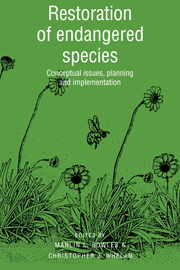Book contents
- Frontmatter
- Contents
- List of contributors
- Foreword
- Acknowledgments
- I Conceptual issues in restoration ecology
- II Restoration planning
- 6 Impacts of biological invasions on the management and recovery of rare plants in Haleakala National Park, Maui, Hawaii
- 7 Disturbance-dependent persistence of rare plants: anthropogenic impacts and restoration implications
- 8 A metapopulation approach to Pitcher's thistle (Cirsium pitcheri) recovery in southern Lake Michigan dunes
- 9 Restoration of woodland caribou to the Lake Superior region
- III Implemented restorations
- IV Synthesis and future directions: biology, politics and reality
- Taxonomic Index
- Subject Index
9 - Restoration of woodland caribou to the Lake Superior region
Published online by Cambridge University Press: 27 January 2010
- Frontmatter
- Contents
- List of contributors
- Foreword
- Acknowledgments
- I Conceptual issues in restoration ecology
- II Restoration planning
- 6 Impacts of biological invasions on the management and recovery of rare plants in Haleakala National Park, Maui, Hawaii
- 7 Disturbance-dependent persistence of rare plants: anthropogenic impacts and restoration implications
- 8 A metapopulation approach to Pitcher's thistle (Cirsium pitcheri) recovery in southern Lake Michigan dunes
- 9 Restoration of woodland caribou to the Lake Superior region
- III Implemented restorations
- IV Synthesis and future directions: biology, politics and reality
- Taxonomic Index
- Subject Index
Summary
Introduction
Woodland caribou (Rangifer tarandus caribou) historically occupied the boreal forest zone across the North American continent. The distribution and abundance of the species has declined in the past century. In particular, it has been extirpated from much of the southern limits of its historical range on both sides of the boundary between Canada and the United States (Bergerud 1974). Translocation of animals from extant populations may be used to reestablish populations in portions of the species' former range. Recently, wildlife biologists in Ontario have translocated woodland caribou to a number of sites in or adjacent to Lake Superior. While it is too soon to evaluate their long-term success, these restoration efforts do provide useful insights into factors likely to influence the outcome of woodland caribou translocations elsewhere. In this chapter, we examine the 1) historical changes in range distribution, 2) natural history characteristics and requirements, and 3) results of recent translocations of woodland caribou, and use them to evaluate several alternative sites for possible woodland caribou restoration in the Lake Superior region. We also apply minimum viable population analysis to evaluate several translocation scenarios.
Distribution of woodland caribou
The woodland caribou's distribution and abundance along the southern edge of its range declined dramatically in the late 1800s and early 1900s (Bergerud 1974). In the Lake Superior region, woodland caribou were extirpated from the mainland of Michigan in 1912 (Baker 1983) and from Isle Royale in 1928.
- Type
- Chapter
- Information
- Restoration of Endangered SpeciesConceptual Issues, Planning and Implementation, pp. 219 - 242Publisher: Cambridge University PressPrint publication year: 1994
- 5
- Cited by



